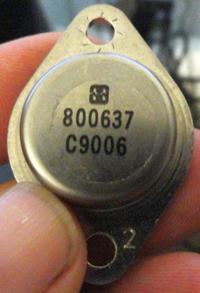gbugh
Member level 5
- Joined
- Mar 15, 2013
- Messages
- 80
- Helped
- 1
- Reputation
- 2
- Reaction score
- 1
- Trophy points
- 1,288
- Location
- Fort Worth, Texas
- Activity points
- 2,236
Does anyone know what is a Harris C9006 800637 TO-3 package used in an oscillator/driver circuit?
The circuit is not working and this part appears to have an internal short but I don't know what it is.
I tried to get support at the Intersil website to find more info but their website hangs up and just keeps saying Please Wait.
Thanks in advance if anyone can help,
George
- - - Updated - - -
It seems like it must be a transistor but I need a datasheet to find a replacement.
The circuit is not working and this part appears to have an internal short but I don't know what it is.
I tried to get support at the Intersil website to find more info but their website hangs up and just keeps saying Please Wait.
Thanks in advance if anyone can help,
George
- - - Updated - - -
It seems like it must be a transistor but I need a datasheet to find a replacement.
Does anyone know what is a Harris C9006 800637 TO-3 package used in an oscillator/driver circuit?
The circuit is not working and this part appears to have an internal short but I don't know what it is.
I tried to get support at the Intersil website to find more info but their website hangs up and just keeps saying Please Wait.
Thanks in advance if anyone can help,
George
